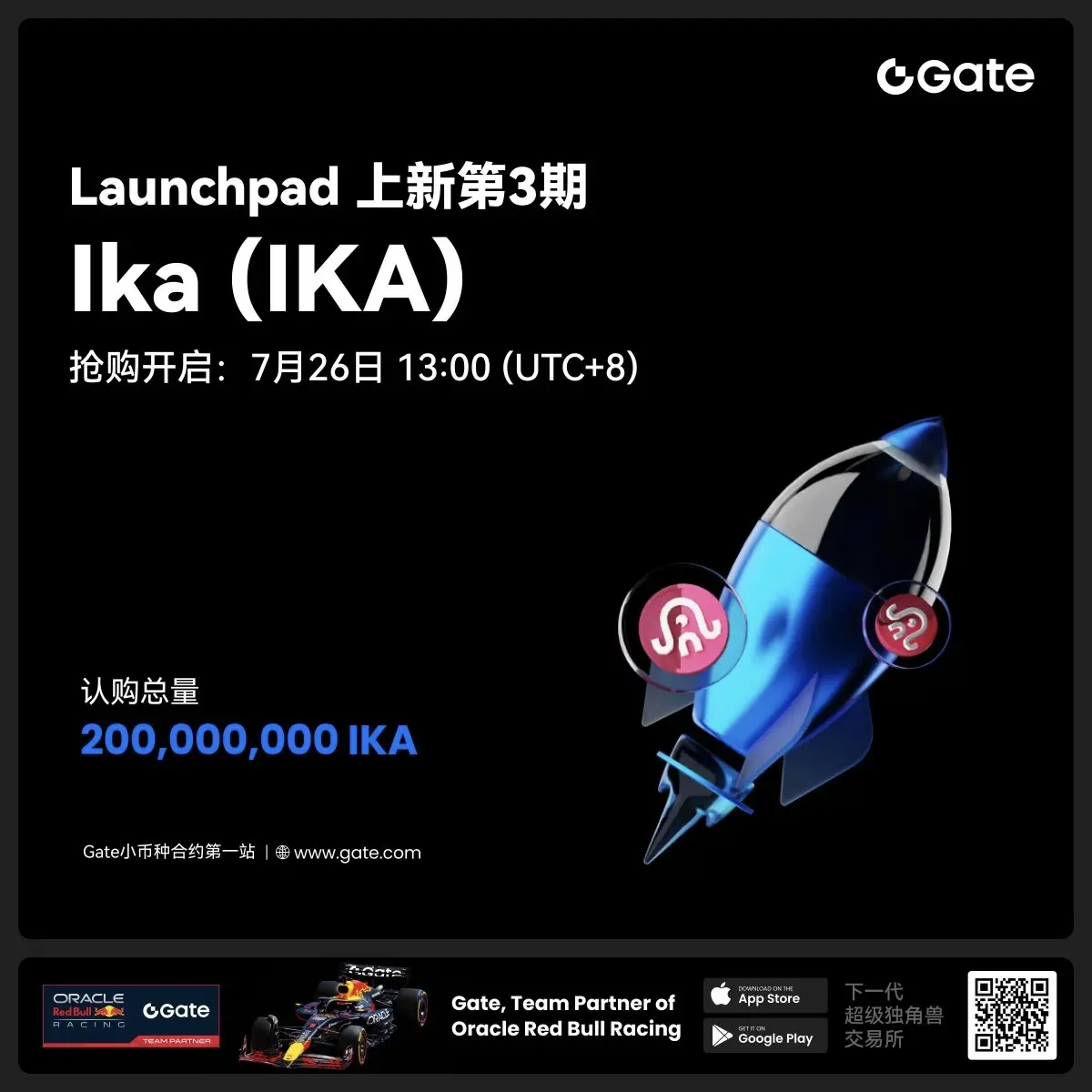- 話題1/3
55774 熱度
14351 熱度
45636 熱度
1583 熱度
1377 熱度
- 置頂
- 親愛的廣場用戶們, #Gate 2025年中社区盛典# 投票中!🔥
🙌 廣場內容達人TOP40榜單新鮮出爐!速速圍觀榜單,爲你喜愛的達人瘋狂打call吧:
www.gate.com/activities/community-vote
每天完成【廣場】互動任務可獲得助力值,每投出30助力值即可參與抽獎一次!
iPhone 16 Pro Max 512G、金牛雕塑、潮流運動套裝、合約體驗券、熱門幣種等你抽!
助力越多,中獎機率越大,下一個抱走iPhone 16的錦鯉就是你!🧧
別猶豫,帶上你的“歐氣”,爲達人衝榜贏大獎!
https://www.gate.com/announcements/article/45974
- 🎉 Gate 廣場 IKA Launchpad 發帖活動來襲!🎉
Gate Launchpad 認購 IKA 最後24小時!曬出你的認購體驗,和大家一起分享,每個人都有機會瓜分 $200 獎池!
🎁 4位幸運分享者*$50合約體驗券每人!
🧐 如何參與:
1.在廣場發帖,帶上 #GateLaunchpad上线IKA# 標籤
2.曬出你的認購截圖 或 分享你的獨特認購小竅門/心得或趣事
3.保證帖子大於50字,內容有趣有料,原創,集齊至少3個互動(點讚/評論/轉發)
IKA認購連結:https://www.gate.com/launchpad/2336?downgarde=true
活動時間:7月28日 12:00 - 7月30日 24:00 (UTC+8)
趕快加入,分享你的精彩時刻,你就是下一個幸運兒!
- 📢 Gate廣場 #创作者活动第二期# 正式開啓!
聚焦 ZKWASM 系列活動,分享你的觀點,瓜分 4,000 枚 $ZKWASM!
ZKWASM 作爲 zk 公鏈先鋒,正在 Gate 平台重磅推廣!
三大活動聯動上線:Launchpool 認購、CandyDrop 空投、Alpha 專屬交易——不要錯過!
🎨 活動一:發布廣場貼文,贏內容獎勵
📅 時間:7月25日 22:00 - 7月29日 22:00(UTC+8)
📌 參與方式:
- 在 Gate 廣場發布與 ZKWASM 或其三大活動相關的原創內容(不少於 100 字)
- 添加標籤: #创作者活动第二期# #ZKWASM#
- 附本人參與 Launchpool/CandyDrop/Alpha 的截圖(如認購、空投或交易)
🏆 獎勵設置:
- 一等獎(1名):1000 枚 $ZKWASM
- 二等獎(2名):500 枚 $ZKWASM
- 三等獎(10名):100 枚 $ZKWASM
📋 評選標準:內容質量、互動量、項目相關性,附活動參與截圖者優先。
📢 活動二:發推贏傳播力獎勵
📌 參與方式:
- 在 X(推特)發布與 ZKWASM 或三大活動相關的原創內容(不少於 100 字)
- 添加標籤: #ZKWASM # GateSquare
- 填寫登記表 👉 https://www.gate.com/quest
- 📢 Gate廣場 #MBG任务挑战# 發帖贏大獎活動火熱開啓!
想要瓜分1,000枚MBG?現在就來參與,展示你的洞察與實操,成爲MBG推廣達人!
💰️ 本期將評選出20位優質發帖用戶,每人可輕鬆獲得50枚MBG!
如何參與:
1️⃣ 調研MBG項目
對MBG的基本面、社區治理、發展目標、代幣經濟模型等方面進行研究,分享你對項目的深度研究。
2️⃣ 參與並分享真實體驗
參與MBG相關活動(包括CandyDrop、Launchpool或現貨交易),並曬出你的參與截圖、收益圖或實用教程。可以是收益展示、簡明易懂的新手攻略、小竅門,也可以是現貨行情點位分析,內容詳實優先。
3️⃣ 鼓勵帶新互動
如果你的帖子吸引到他人參與活動,或者有好友評論“已參與/已交易”,將大幅提升你的獲獎概率!
MBG熱門活動(帖文需附下列活動連結):
Gate第287期Launchpool:MBG — 質押ETH、MBG即可免費瓜分112,500 MBG,每小時領取獎勵!參與攻略見公告:https://www.gate.com/announcements/article/46230
Gate CandyDrop第55期:CandyDrop x MBG — 通過首次交易、交易MBG、邀請好友註冊交易即可分187,500 MBG!參與攻略見公告:https://www.gate.com/announcements
- 📢 #Gate广场征文活动第三期# 正式啓動!
🎮 本期聚焦:Yooldo Games (ESPORTS)
✍️ 分享獨特見解 + 參與互動推廣,若同步參與 Gate 第 286 期 Launchpool、CandyDrop 或 Alpha 活動,即可獲得任意獎勵資格!
💡 內容創作 + 空投參與 = 雙重加分,大獎候選人就是你!
💰總獎池:4,464 枚 $ESPORTS
🏆 一等獎(1名):964 枚
🥈 二等獎(5名):每人 400 枚
🥉 三等獎(10名):每人 150 枚
🚀 參與方式:
在 Gate廣場發布不少於 300 字的原創文章
添加標籤: #Gate广场征文活动第三期#
每篇文章需 ≥3 個互動(點讚 / 評論 / 轉發)
發布參與 Launchpool / CandyDrop / Alpha 任一活動的截圖,作爲獲獎資格憑證
同步轉發至 X(推特)可增加獲獎概率,標籤:#GateSquare 👉 https://www.gate.com/questionnaire/6907
🎯 雙倍獎勵機會:參與第 286 期 Launchpool!
質押 BTC 或 ESPORTS,瓜分 803,571 枚 $ESPORTS,每小時發放
時間:7 月 21 日 20:00 – 7 月 25 日 20:00(UTC+8)
🧠 寫作方向建議:
Yooldo
全球穩定幣市值突破2300億美元 USDC、USDT雙雄領跑
穩定幣的崛起:加密行業的關鍵環節
在當今加密貨幣領域,穩定幣已成爲不可或缺的重要組成部分。其獨特價值不僅體現在加密資產交易的媒介功能,更在跨境支付結算等傳統金融場景中展現出革命性潛力。最新行業數據顯示,截至2025年4月9日,全球穩定幣流通市值已達2367億美元。包括頂級資管機構以及主要經濟體正加速布局這一賽道。某知名穩定幣發行商近期也已正式向美國SEC提交招股書,預計以50-70億美元估值上市,這成爲行業蓬勃發展的縮影。
一、穩定幣的本質與應用
穩定幣是一種理論上能夠長期保持在某一特定價格的加密貨幣,其核心特徵在於通過特定機制維持幣值的相對穩定。需要明確區分的是,央行數字貨幣並不屬於穩定幣範疇。央行數字貨幣與傳統法幣保持1:1等值兌換關係,本質上屬於法定貨幣的數字化形態創新。而加密行業語境下的穩定幣多由私營主體發行,其價值錨定依賴商業信用、抵押資產或算法協議維持。
穩定幣的出現解決了加密貨幣世界中的價值儲存問題。投資者可以通過使用穩定幣購買其他加密貨幣,在投資後將其換回穩定幣,從而鎖定收益或損失。這是穩定幣在加密貨幣市場最初的應用場景之一。
除了加密貨幣市場,穩定幣還廣泛應用於DeFi、跨境支付結算等領域。在傳統跨境支付領域,資金流轉仍高度依賴銀行體系,面臨流程繁瑣、成本高昂等挑戰。相比之下,穩定幣支付展現出顯著的效率和成本優勢。一筆跨境轉帳通常可在2分鍾內完成,實現T+0即時結算。交易成本也遠低於傳統銀行體系。
在去中心化金融(DeFi)領域,穩定幣已成爲其生態運轉的基石資產。作爲DeFi協議中重要的價值媒介,穩定幣爲各類去中心化平台提供穩定且充足的流動性支持,優化了交易與借貸的經濟模型。
二、主流穩定幣類型及特點
目前市場上主流穩定幣可分爲:法定貨幣抵押、加密貨幣抵押、實物資產抵押以及基於算法的穩定幣。
(一) 法定貨幣掛鉤穩定幣
盡管USDT在合規性方面存在短板,但其在加密生態系統中構建的完整網路效應使其仍能維持高市值。USDT在合法交易場景和非傳統應用中的雙重滲透能力是其成功的關鍵。
(二) 加密資產掛鉤穩定幣
DAI
(三) 實物資產掛鉤穩定幣
PAXG
(四) 基於算法的穩定幣
算法穩定幣通過智能合約算法維持幣值穩定,不依賴實物儲備。但由於過度依賴算法設計,容易在極端市場條件下失去價格錨定。2022年UST暴雷事件暴露了算法穩定幣的致命缺陷,導致該類項目陷入長期低迷。
三、穩定幣的價值基礎與風險
穩定幣的價值根基建立在雙重支撐之上:一是錨定的實物或數字資產作爲底層保障,二是市場共識驅動的流通性與信任機制。共識決定了使用範圍和流動性,儲備資產充足性直接關聯抗風險能力。兩者的動態平衡構成了穩定幣體系的核心穩定性。
然而,穩定幣的"穩定"屬性並非絕對。當市場共識出現裂痕或儲備資產遭遇系統性風險時,很可能面臨幣價波動甚至脫錨的風險。爲了應對可能的極端風險,保護持有者權益,相關的監管框架與技術保障機制仍需進一步完善。